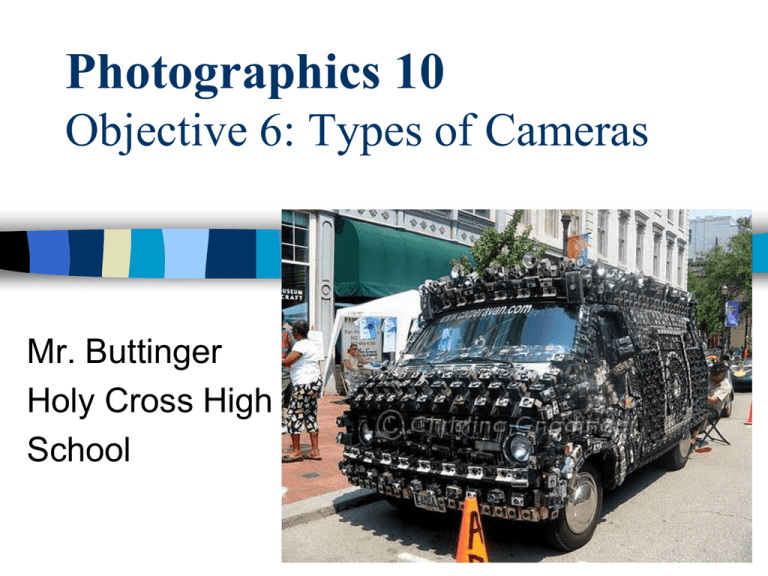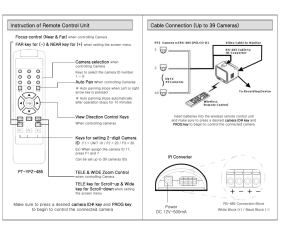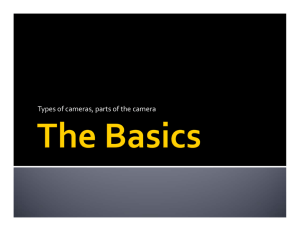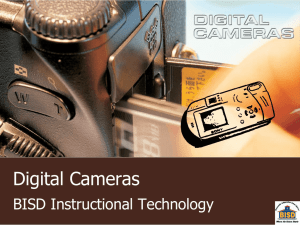Photography 10 Module 2: Types of Cameras
advertisement

Photographics 10 Objective 6: Types of Cameras Mr. Buttinger Holy Cross High School Types of Cameras Film Cameras -Rangefinder Camera -35 mm (Compact, SLR) -Medium Format , Large Format -Polaroid -Pinhole Camera Digital Cameras - Compact and SLR - Medium and Large Format Film Cameras Cameras vary based on the size of their negatives: 35mm film cameras -Most commonly used – smaller size Medium format cameras -measured in cm (6x6, 6x9, etc…) Large format cameras -measured in inches ( 4 x 5inches, 8 x 10 inches, etc…) Types of Cameras The main categories of Camera: 1. Point and Shoot (Compact) –Film or Digital (usually fully automatic) 2. Single Lens Reflex (SLR) -Film or Digital -(exchangeable lenses and flashes) The SLR Camera The Single Lens Reflex Camera This camera is portable and extremely adaptable. The original design has now evolved into a multiplicity of models, the majority of which have a formidable array of lenses and accessories. When you look through the viewfinder of an SLR camera … what you see is what the lens “sees”. The SLR Camera How Canon DSLR Cameras Work - YouTube The SLR Camera Canon 35 mm SLR Olympus 35 mm SLR 3. Rangefinder The Rangefinder Camera Although the Rangefinder does not have quite as wide a range of accessories as the SLR, it is a sturdy and reliable camera. The Rangefinder is available in 35mm or medium format models. The Rangefinder Camera This is a camera that is very popular with professional photographers. The most famous brand is the Leica. In contrast to the SLR, the rangefinder allows the subject to be seen through a separate viewfinder rather than through the lens. When the lens is focused on the subject, these two images become aligned with one another and the picture will then be sharp. 4. Medium Format Cameras 5. Large Format Cameras Medium Format Camera The Large Format Camera This is a large format, tripod-mounted camera which takes photographs where the transparencies or negatives are 5 x 4 inches. The film is loaded into dark slides, each one holding just two sheets. There is no viewfinder in the conventional sense: the image is seen upside-down and back-to-front on a ground glass screen. In order to see the image and keep out any stray light the photographer covers the camera and his head with a dark cloth. The Large Format Camera The range of applications of the 5 x 4 camera is varied both in the studio and on location. It produces pictures with excellent clarity and sharpness of detail. YouTube - 4x5 camera demonstration 6. Polaroid Cameras 7. Pin Hole Cameras The Instant and Polaroid Camera As well as providing an immediate image of the subject, these cameras also offer as many possibilities for creative photography as their conventional counterparts. The Instant and Polaroid Camera Instant picture cameras such as the Polaroid offer another dimension to picture-taking. After the picture is taken, the film is impregnated with the chemicals required for processing the image and the picture begins to appear only seconds after the shutter is pressed. Development is complete within minutes.










